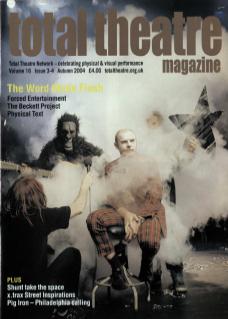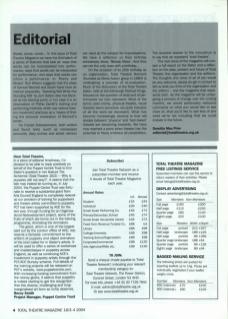Words, words, words... In this issue of Total Theatre Magazine we have the first batch of a series of features that look at: ways that words can be incorporated into performance; ways that words can be interpreted for performance; and ways that words can inform a performance. In ‘Poetry and Motion’ Tom Wilson suggests that the plays of Samuel Beckett and Sarah Kane have an intrinsic physicality. ‘Standing Still While Not Standing Still' by Jerri Daboo also has Beckett as her starting point; in her case it is an observation of Phillip Zarrilli's training and performing methods which use various Eastern movement practices as a means of finding the physical realisation of Beckett's words.
For Forced Entertainment, both written and found texts (such as newspaper accounts, diary entries and street names) are used as the catalyst for improvisations. We have a reflection on their birthday anniversary show, Bloody Mess. And they are not the only ones with a birthday...
On the occasion of its 20th birthday as an organisation, Total Theatre Network (founded as Mime Action group in 1984) is undergoing a process of re-evaluation. Much of the discussion at the Total Theatre Salon, held at the Edinburgh Festival Fringe, focused on the question of what sort of performance we now represent. Most of the terms used (mime, physical theatre, visual theatre) seem somehow not quite inclusive of all the work we represent. What has become increasingly obvious is that old divides between 'physical' and 'text-based' theatre are becoming obsolete. We have now reached a point when theatre has the potential to freely embrace all possibilities.
The simplest answer to the conundrum is to say that we represent ‘total theatre'.
The next issue of the magazine will contain a full report on the Salon and a reflection on the past, present and future of Total Theatre (the organisation and the artform). The thoughts and views of all of you would be very welcome; please do get in contact to tell us what you think of the organisation and the artform – and the magazine that represents both. As the magazine will be undergoing a process of change over the coming months, we would particularly welcome comments on what you would like to see more of, what you'd like to see less of and what we're not including that we could include in the future.

